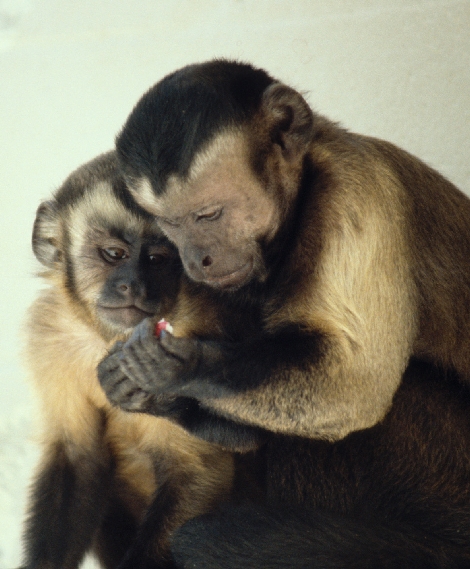Tufted Capuchin (Cebus apella) - Wiki Tufted Capuchin
From Wikipedia, the free encyclopedia
[Photo] Brown Capuchin Monkeys Sharing. Tufted Capuchin (Cebus apella), also known as Brown Capuchin or Black-capped Capuchin. Source Powell K: Economy of the Mind. PLoS Biol 1/3/2003: e77. http://dx.doi.org/10.1371/journal.pbio.0000077 Date Published: December 22, 2003 Author (Photo : Frans de Waal.)
The Tufted Capuchin (Cebus apella), also known as Brown Capuchin or Black-capped Capuchin is a New World primate from South America. It is one of the more widespread species of primates in the neotropics.
Tufted Capuchins are omnivorous animals, mostly feeding on fruits and invertebrates, although they sometimes feed on small vertebrates (e.g. lizards and bird chicks) and other plant parts. It can be found in many different kinds of environments, including moist tropical and subtropical forest, dry forest and disturbed or secondary forest.
Like other capuchins, these are social animals, forming groups of 8 to 15 individuals, and are led by an alpha or dominant male.
Physical characteristics
The Tufted Capuchin is more powerfully built than the other capuchins, with rougher fur and a short, thick tail. It has a bundle of long, hardened hair on the forehead that can be raised as a sort of "wig". The fur is brownish gray, with the belly being somewhat lighter colored than the rest of the body. The hands and feet are black. The tail is strong and can be used as a grasping tail.
The Tufted Capuchin has a head-body length of 32 to 57 cm, a tail length of 38 to 56 cm and a weight of 1.9 to 4.8 kg, with the males generally being larger and heavier than the females.
Distribution and habitat
This species lives in the northern Amazon rainforest of the Guyanas and Brazil to the west of the Rio Negro, as far north as the Orinoco in Venezuela. It can be found in a large variety of forest types, mainly in tropical rainforests (up till a height of 2700 m), but also in more open forests.
The biological range overlaps with that of other species of capuchin, like the White-headed Capuchin (C. capucinus).
Behaviour
The Tufted Capuchin is a diurnal, arboreal primate species, but it often forages on the ground to search for food or to walk longer distances between trees that are too far apart to jump. During the night, the capuchin rests in a hollow tree or between dense branches.
The Tufted Capuchin lives a solitary live, or in groups of two to twenty animals. A single group usually contains only one adult male, but mixed groups with multiple males do also occur. In that case one of the males is dominant. He accepts only a few apes in his direct surroundings, mainly younger animals and a few females. The dominant male and the group members that are close to him have the privilege to eat first in case of food scarcity, while subordinate apes have to wait until they are ready.
As opposed to some other capuchins, a group of Tufted Capuchins has no fixed territory. Different groups are often encountered in the same area.
After a gestation period of 180 days, one young is born, or incidentally a twin. This young, which weights only 200 to 250 grams, is carried on the back of its mother. The mother feeds her child for 9 months, but the young is sexually immature until its seventh year, which is quite late for a primate of its size.
Important natural enemies of the capuchin are large birds of prey. They are so afraid of those birds, that they even alarm when a harmless bird flies over.
Food
A well-known characteristic of this species is that it uses stones as a tool to open hard nuts. First it lays the nut on a large, flat stone, after which it hammers with a smaller stone until the nut is opened. Besides nuts, it also eats fruit, insects, larvae, eggs, young birds, frogs, lizards, and even bats.
Tufted Capuchins look for their food in groups. As soon as one of the group members has found something edible, he/she makes a large whistling sound so that the other monkeys know that there is something to eat. The composition of the group is very well-organized and is determined by rankt in the hierarchy. The dominant male often resides somewhere in the middle of the group just behind the front line, so that it is safer when a predator attacks. The vanguard is composed of higher-ranked females who are tolorated by the dominant male. They have to privilege to reach the food first, but they are also the most vurnerable when a predator attacks.
http://en.wikipedia.org/wiki/Tufted_Capuchin
| The text in this page is based on the copyrighted Wikipedia article shown in above URL. It is used under the GNU Free Documentation License. You may redistribute it, verbatim or modified, providing that you comply with the terms of the GFDL. |
